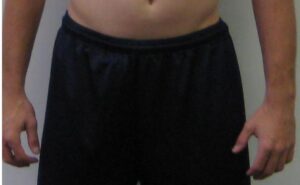Static Posture Assessment Mistakes: Part 1
One of the big mistakes many people make in assessing static postures is that they think they can determine that the humerii are internally rotated just from looking at someone from in front, and seeing the tops of their hands (as opposed to the thumb-side, which would be more neutral). So, in these folks’ minds, this individual would need to stretch more into external rotation:

In reality, this individual is a professional pitcher and actually has far more external rotation (roughly 130 degrees on his throwing side) than ordinary folks. Stretching him into external rotation could actually cause injury.
So, why are his palms turned backward like that? Well, it’s very simple: his scapulae are abducted, or winged. When the scapular stabilizers – particularly the serratus anterior and lower trapezius are weak – the shoulder blades sit further out to the sides. The humerii are in normal, but their “foundation” (the scapulae) have been moved.
For more information on optimal assessment techniques, check out Assess and Correct.



